最新译林牛津版初中英语七年级上册课程Unit 5 公开课教学设计
- 格式:doc
- 大小:32.00 KB
- 文档页数:5
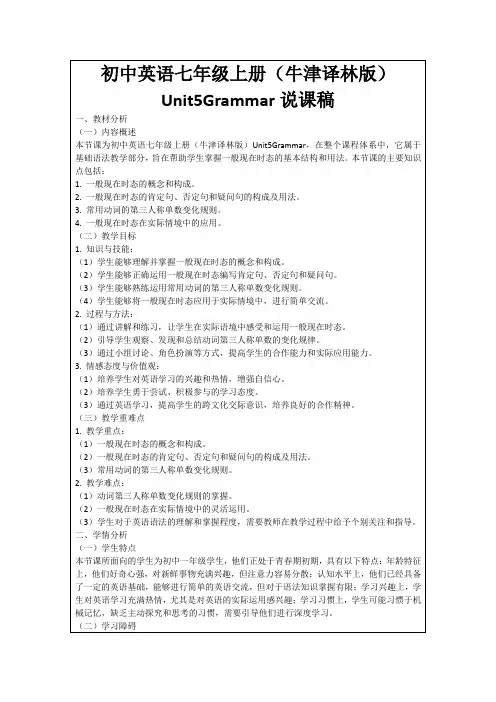
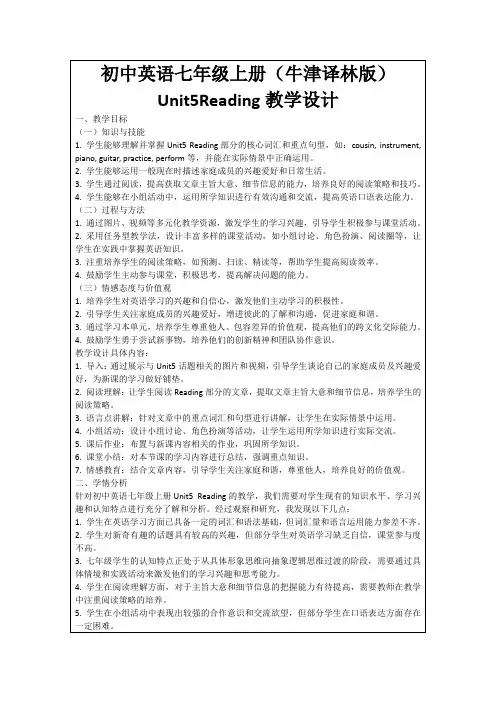
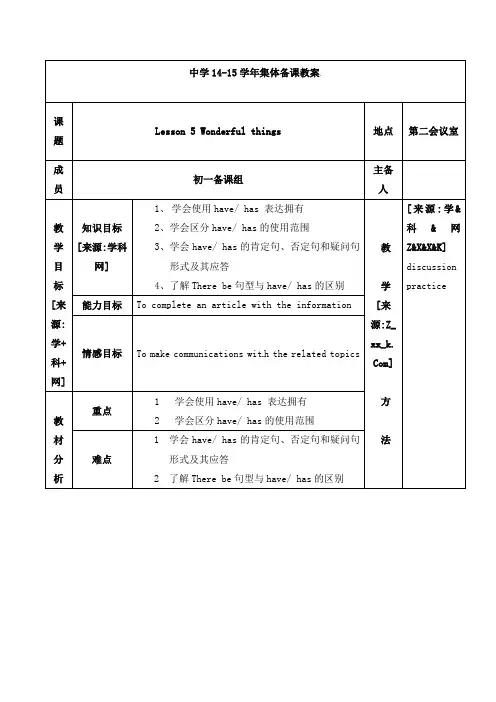
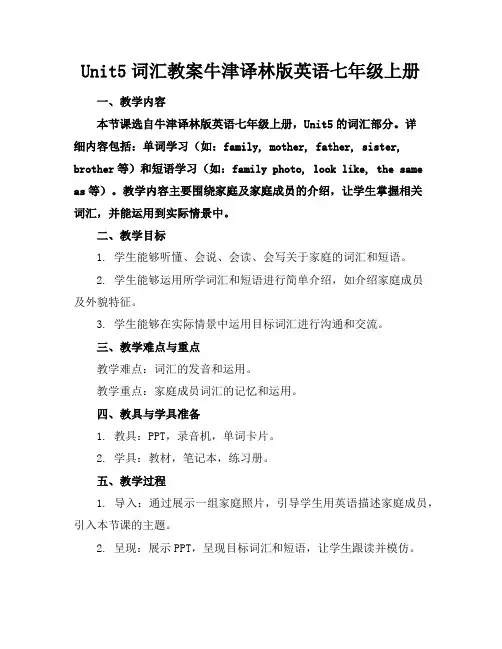
Unit5词汇教案牛津译林版英语七年级上册一、教学内容本节课选自牛津译林版英语七年级上册,Unit5的词汇部分。
详细内容包括:单词学习(如:family, mother, father, sister, brother等)和短语学习(如:family photo, look like, the same as等)。
教学内容主要围绕家庭及家庭成员的介绍,让学生掌握相关词汇,并能运用到实际情景中。
二、教学目标1. 学生能够听懂、会说、会读、会写关于家庭的词汇和短语。
2. 学生能够运用所学词汇和短语进行简单介绍,如介绍家庭成员及外貌特征。
3. 学生能够在实际情景中运用目标词汇进行沟通和交流。
三、教学难点与重点教学难点:词汇的发音和运用。
教学重点:家庭成员词汇的记忆和运用。
四、教具与学具准备1. 教具:PPT,录音机,单词卡片。
2. 学具:教材,笔记本,练习册。
五、教学过程1. 导入:通过展示一组家庭照片,引导学生用英语描述家庭成员,引入本节课的主题。
2. 呈现:展示PPT,呈现目标词汇和短语,让学生跟读并模仿。
3. 实践:分组活动,让学生用目标词汇和短语进行自我介绍,介绍自己的家庭成员。
4. 例题讲解:讲解单词和短语的用法,结合实际例句进行讲解。
5. 随堂练习:让学生完成练习册上的相关练习,巩固所学内容。
六、板书设计1. Unit5 Family2. 主要内容:单词:family, mother, father, sister, brother, grandpa, grandma等短语:family photo, look like, the same as等七、作业设计1. 作业题目:根据所学内容,完成一篇关于家庭成员的介绍。
2. 答案示例:My name is Tom. I have a happy family. There are five people in my family. They are my father, mother, sister, brother and me. My father is a teacher and he is tall and strong. My mother is a doctor and she is kind and friendly. My sister is in Grade 8 and she likes singing. My brother is in Grade 6 and he is good at playing basketball. We all love each other and spend a lot of time together.八、课后反思及拓展延伸1. 课后反思:关注学生在课堂上的参与度,了解他们对词汇和短语的掌握情况,对教学效果进行评估。
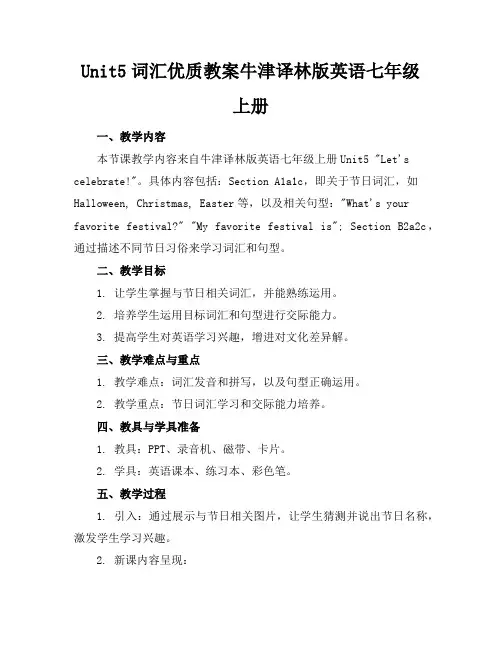
Unit5词汇优质教案牛津译林版英语七年级上册一、教学内容本节课教学内容来自牛津译林版英语七年级上册Unit5 "Let's celebrate!"。
具体内容包括:Section A1a1c,即关于节日词汇,如Halloween, Christmas, Easter等,以及相关句型:"What's your favorite festival?" "My favorite festival is"; Section B2a2c,通过描述不同节日习俗来学习词汇和句型。
二、教学目标1. 让学生掌握与节日相关词汇,并能熟练运用。
2. 培养学生运用目标词汇和句型进行交际能力。
3. 提高学生对英语学习兴趣,增进对文化差异解。
三、教学难点与重点1. 教学难点:词汇发音和拼写,以及句型正确运用。
2. 教学重点:节日词汇学习和交际能力培养。
四、教具与学具准备1. 教具:PPT、录音机、磁带、卡片。
2. 学具:英语课本、练习本、彩色笔。
五、教学过程1. 引入:通过展示与节日相关图片,让学生猜测并说出节日名称,激发学生学习兴趣。
2. 新课内容呈现:a. 播放Section A 1a录音,让学生跟读并学习节日词汇。
b. 利用卡片和PPT展示节日图片,引导学生用目标词汇进行描述。
c. 通过小组活动,让学生相互询问并回答最喜欢节日,练习句型。
3. 例题讲解:结合Section B 2a2c内容,讲解如何描述节日习俗,并进行示范。
4. 随堂练习:让学生模仿例题,用目标词汇和句型描述他们最喜欢节日。
5. 小组活动:学生分成小组,讨论各自喜欢节日,并进行汇报。
六、板书设计1. 板书左侧:列出本节课节日词汇。
2. 板书右侧:展示句型和相关语法点。
3. 中间部分:用表格形式呈现各节日主要习俗。
七、作业设计1. 作业题目:a. 用英语写一篇关于自己最喜欢节日短文,包括节日名称、时间、习俗等。
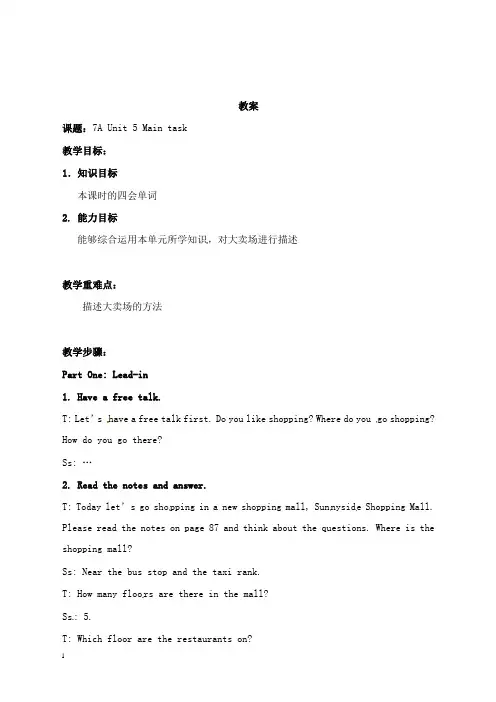
教案课题:7A Unit 5 Main task教学目标:1.知识目标本课时的四会单词2. 能力目标能够综合运用本单元所学知识,对大卖场进行描述教学重难点:描述大卖场的方法教学步骤:Part One: Lead-in1. Have a free talk.T: Let’s have a free talk first. Do you like shopping? Where do you go shopping? How do you go there?Ss: …2. Read the notes and answer.T: Today let’s go sho pping in a new shopping mall, Sun nyside Shopping Mall. Please read the notes on page 87 and think about the questions. Where is the shopping mall?Ss: Near the bus stop and the taxi rank.T: How many floors are there in the mall?Ss: 5.T: Which floor are the restaurants on?Ss: The top floor.T: Is there a big cinema in the mall?Ss: Yes.T: Are there many people in the computer games centre?Ss: Yes.3. Fill in the blanks.T: Please fill in the blanks on page 87.Please read the article together.Part Two: Writing structureT: How many parts are there in this article?Ss: Three.T: What are the three parts?Ss: …T: Part One is Paragraph One, introduction.Part Two is from Paragraph Two to Paragraph Five, main body.Part Three is Paragraph Six, conclusion.What are the thr ee parts abou t?Ss: …T: Part One is about where the shopping mall is.Part Two introduces what’s on each floor.Part Three tells us it’s a good place to go.Part Three: Outline1. Group work.T: Today we’re going to write about another shopping mall, Star Shopping Mall. What can you see in Star Shopping Mall? Please work in groups of four to talk about Star Shopping Mall according to the picture. Each student describes one floor and introduces it to the others.2. Complete the notes.T: Please complete the notes about Star Shopping Mall.Ss: …T: After finishing the notes, can you write an outline for the writing? Ss: …Part Four: PracticeAsk Ss to write about Star Shopping Mall.家庭作业:1. Read the article on page 87.2. Write an article about Star Shopping Mall.教案课题:7A Unit 5 Integrated skills教学目标:1.知识目标本课时的四会单词2. 能力目标1) 培养学生“听”、“说”的技能2) 能够在购物时正确使用英语教学重难点:1. “听”获取信息2. 能够在购物时正确使用英语教学步骤:Part One: Pre-listeningT: Today let’s talk about pocket money. Do you have pocket money? How do you spend your pocket money? How about our friends Daniel, Simon, Sandy and Millie? How do they spend their pocket money? Let’s guess.Part Two: While-listening1. Listen and finish Part A.T: Please listen to the tape and finish Part A on page 84. Let’s check the answers.2. Listen and fill in th e blanks.T: After listening, please fill in the blanks.3. Listen and write.T: Simon often spends money on football cards. What else does he like to buy? Ss: CDs, sports shoes, stationery a nd T-shirts.T: How often does he buy CDs?Ss: Sometimes.T: How oft en does he buy sports shoes, stationery and T-shirts? Please listen and answer.Ss: …Do poor children spend pocket money like Simon?Ss: No.T: Please look at the table on page 84. How often do poor children buy CDs? Ss: Never.T: How often do they buy sports shoes, stationery and T-shirts? Please listen again and write down the answers.Ss:…Part Three: Post-listeningT: Please read the advertisement on page 84 and complete the letter on page85. Let’s read this letter together.Part Four: Speak up1. L isten and answer.T: We know Simon always spends his pocket money on football boots. Today he wants to buy a new pair. How much are the football boots? Please listen and think about this question.Ss: …2. Read and answer.T: Please read after the tape a nd think about these questions.Ss: …1.Read it in groups.2.Do an activity.T: Suppose you’d like to buy other things. Please work in groups of three and talk about the things in Part C2 on page 85. Use the dialogue in Part C1 as a model.家庭作业:1 Read the dialogue on page 85.2 Complete the following dialogue according to the Chinese sentences.王兰打算买一条尺寸为24号的牛仔裤,可试穿后发现有点小。

Unit5 Integrated skills教学目标1.能通过阅读和听录音获取有关信息。
2.能从对话中找到不同购物习惯的具体信息。
3.能运用一般疑问句表达购物的请求。
教学内容词汇:poor area, yours sincerely, a pair of, football boots, try on, of course, too large, too small, in the name of, raise money for…句型:What’s your size? I am a size eight.Could I try them on, please?They fit very well.That’s too expensive.Step1 Lead-inShow Ss pictures, present them some questions and lead in today’s topic “shopping”. Try to attract Ss’ attention and interest about the learning contents.When is Christmas? Would you like to buy presents for your family members? What do you want to buy? Where can we buy these things?Step2 Listeni ng & reading (speak up)A) Simon and his mother is in t he shoe shop. They are talking to the shopkeeper and let see what they are talking about.1.Present Ss some questions (before listening to the tape, ask Ss toreading the questions)1).What does Simon want to buy?He wants to b uy a pair of football boots.2).What size are Simon’s feet?He is a size eight.3).What does Mrs Luo think of the shoes?That’s too expensive.2.Play the tape for Ss and answer the questions about shoes, then readthe dialogue together.B) If you go to the shopping mall, what would you like to choose? (a pair of jeans, skirt, jacket) Ask Ss to make a dialogue with their partner (Work in groups of three):Shopkeeper: Hello, can I help you?A:Hello. I’d like to buy …Shopkeeper: What’s your size?A: I’m a size… . I like this one / pair. Could I try it / them on, please?Shopkeeper: Yes, of course.A: Well, it / they fit(s) very well. How much is it / are they? Shopkeeper:It is / They’re ……yuan.Mum:Oh. That’s too …Do you have a …… one?Step3 Presentation & Practice1. Ask Ss about their pocket money. Do you have any pocket money ? A: How do you spend your pocket money?B: I spend my pocket money buying---I spend my pocket money on ---2. How do Simon and his friends spend their pocket money? choose the right things for them.3. We have lots of pocket money to use. What about the children in this picture?Play the tape for students and ask them to fill in the blanks with “sometimes”“always” and “never”.3.Ask Ss to read the ad in the newspaper on P84, answer the questionsand fill in the blanks with key information.1) Who don’t have enough stationery to use? Children in poor areas / in need.2) What can people do to help the children? Collect some stationery for them / Donate some money to them.3) We would like to help the children in___________ in our country. Can we send them some stationery in the name of our school? We______________ rulers, rubbers, notebooks, writing paper,_________ and ______________ for those children now. We would also like to raise some_____________ for them.Step4 Discussion1.A video for Ss about children in poor areas. Ask them to discuss ingroups abou t the question: How can we help the children in poor areas?(we can / should)2.Present Ss some good ideas: Collect stationery like pencils notebooks,writing paper for the poor children. / Save our pocket money. / Raise some money for the poor children.3.Everyone needs help sometimes. We should be helpful to each other. Love actually is all around.4. The girl’s name is Lily. She comes from the poor areas. Pleas e writea letter to her. Tell Lily: Who are you? Where are you from? Talk about your school and study. What can you do to help her and her classmates? Step5 Ho mework1. Finish the letter and send it to Lily.2. Try to do exercises on P87教学反思:本节课课型是Integrated Skills综合技能,目的是为了训练加强学生听说读的综合能力。
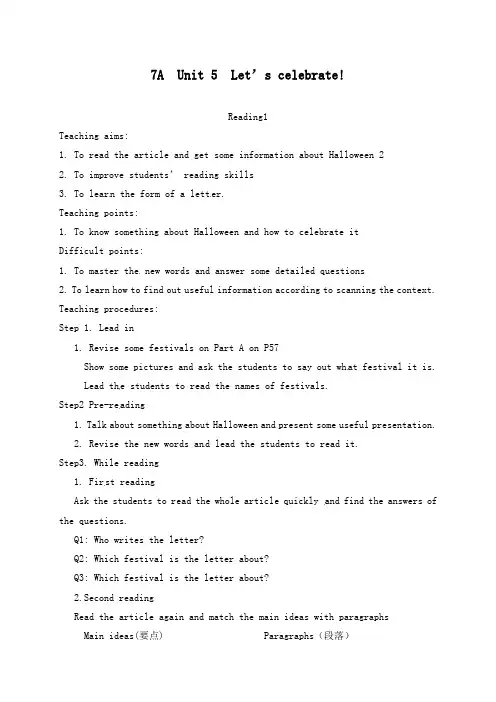
7A Unit 5 Let’s celebrate!Reading1Teaching aims:1. To read the article and get some information about Halloween 22. To improve students’ reading skills3. To learn the form of a lett er.Teaching points:1. To know something about Halloween and how to celebrate itDifficult points:1. To master the new words and answer some detailed questions2. To learn how to find out useful information according to scanning the context. Teaching procedures:Step 1. Lead in1. Revise some festivals on Part A on P57Show some pictures and ask the students to say out what festival it is. Lead the students to read the names of festivals.Step2 Pre-reading1. Talk about something about Halloween and present some useful presentation.2. Revise the new words and lead the students to read it.Step3. While reading1. Fir st readingAsk the students to read the whole article quickly and find the answers of the questions.Q1: Who writes the letter?Q2: Which festival is the letter about?Q3: Which festival is the letter about?2.Second readingRead the article again and match the main ideas with paragraphsMain ideas(要点) Paragraphs(段落)a. They have a party. 4b. They play “trick or treat”. 3c. Wendy likes Halloween best. 1d. How to celebrate Halloween? 23. Third readingAsk the students to read each paragraphs and finish different excises. (1)Read Para2 and answerQ1: When is Halloween?Q2: How do people in the USA celebrate Halloween? dress up √paint faces √make apple lanternswear masks √let off fireworks(2)Read Para3 and fill in the blanksWe ____ houses and ________ with the people inside. We _____ their doors and ______ “trick or treat”. Usually they _____ us _______ as ______. If they do not give us a treat, we ________ on them.(3) Read Para4 and answer 2 questionsQ1: When do they have the party?Q2: What do they eat a t the party?(4) Ask the students to read the articles by themselves and then finish the excises.Step 4. Finish the excises.1.Finish Part B1 on P59 and check the answersHalloweenDate: 31 __________Activities: _____ upWear ______ or paint their _____Make ________________Play _________________2. Do ‘ True or False’ on P59 and if the sentence is false ,students need tocheck it.(1) People in the USA celebrate Halloween in October.(2) Halloween is not much fun for children.(3) People make lanterns out of oranges.(4) Children play “trick or treat” with their parents on Halloween.(5) People have a party on the morning of 31 October.(6) People enjoy nice food and drinks on Halloween. Step 7 ActivityAsk the students to talk about How to treat festivals in different countries?Step6 Homework1. Read after the tape for 5 times, try to imitate the pronunciation of eachsentence.2. Finish the excises on the paper.。
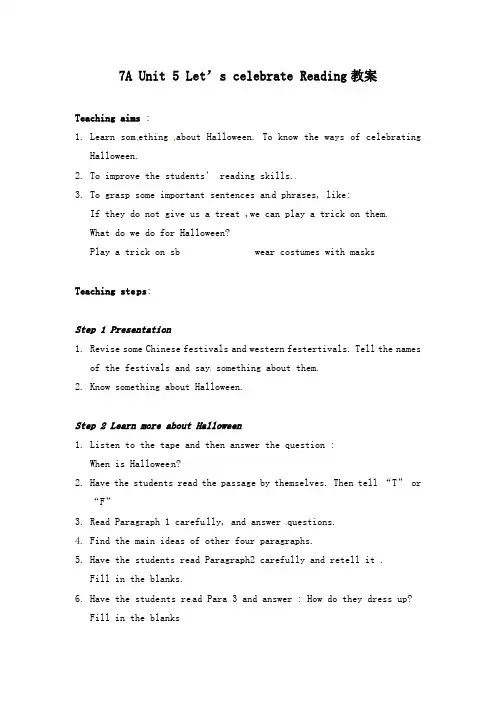
7A Unit 5 Let’s celebrate Reading教案Teaching aims :1.Learn som ething about Halloween. To know the ways of celebratingHalloween.2.To improve the students’ reading skills.3.To grasp some important sentences an d phrases, like:If they do not give us a treat ,we can play a trick on them.What do we do for Halloween?Play a trick on sb wear costumes with masks Teaching ste ps:Step 1 Presentation1.Revise some Chinese festivals and western festertivals. Tell the namesof the festivals and say something about them.2.Know something about Halloween.Step 2 Learn more about Halloween1.Listen to the tape and then answer the question :When is Hallowee n?2.Have the students read the passage by themselves. Then tell “T” or“F”3.Read Paragraph 1 carefu lly, and answer questions.4.Find the main ideas of other four paragraphs.5.Have the students read Paragraph2 carefully and retell it .Fill in the blanks.6.Have the stude nts read Para 3 and answer : How do they dress up?Fill in the blanks7.Look at the picture ,learn to make a pumpkin lantern.Fill in the balnks.8.Learn some pictures and answer questions ,fill in the blanks.Step 3 ConsolidationRead the passage together.Step 4 PractiseDo some exercixes.Step 5 Homework.1.Finish the exer cises in the paper.2.Retell the passage.3.。
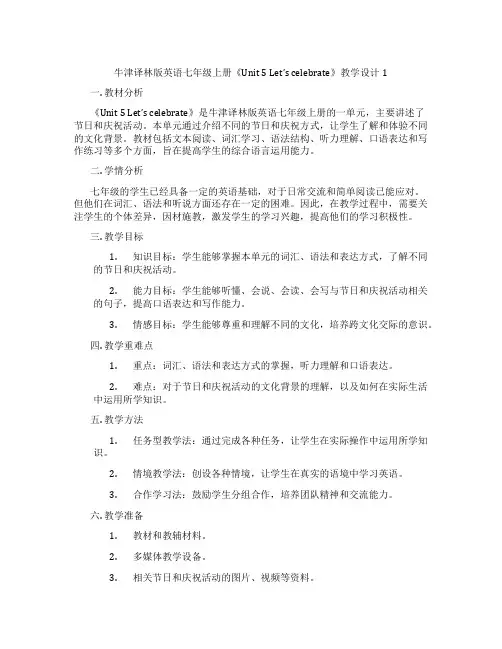
牛津译林版英语七年级上册《Unit 5 Let’s celebrate》教学设计1一. 教材分析《Unit 5 Let’s celebrate》是牛津译林版英语七年级上册的一单元,主要讲述了节日和庆祝活动。
本单元通过介绍不同的节日和庆祝方式,让学生了解和体验不同的文化背景。
教材包括文本阅读、词汇学习、语法结构、听力理解、口语表达和写作练习等多个方面,旨在提高学生的综合语言运用能力。
二. 学情分析七年级的学生已经具备一定的英语基础,对于日常交流和简单阅读已能应对。
但他们在词汇、语法和听说方面还存在一定的困难。
因此,在教学过程中,需要关注学生的个体差异,因材施教,激发学生的学习兴趣,提高他们的学习积极性。
三. 教学目标1.知识目标:学生能够掌握本单元的词汇、语法和表达方式,了解不同的节日和庆祝活动。
2.能力目标:学生能够听懂、会说、会读、会写与节日和庆祝活动相关的句子,提高口语表达和写作能力。
3.情感目标:学生能够尊重和理解不同的文化,培养跨文化交际的意识。
四. 教学重难点1.重点:词汇、语法和表达方式的掌握,听力理解和口语表达。
2.难点:对于节日和庆祝活动的文化背景的理解,以及如何在实际生活中运用所学知识。
五. 教学方法1.任务型教学法:通过完成各种任务,让学生在实际操作中运用所学知识。
2.情境教学法:创设各种情境,让学生在真实的语境中学习英语。
3.合作学习法:鼓励学生分组合作,培养团队精神和交流能力。
六. 教学准备1.教材和教辅材料。
2.多媒体教学设备。
3.相关节日和庆祝活动的图片、视频等资料。
4.录音机和听力材料。
七. 教学过程1.导入(5分钟)利用图片和视频介绍不同的节日和庆祝活动,激发学生的兴趣。
2.呈现(10分钟)展示本节课的主要内容,包括词汇、语法和表达方式。
通过幻灯片或板书,清晰地呈现教学重点。
3.操练(15分钟)让学生进行听力练习,听懂并模仿所给的句子。
然后进行分组讨论,让学生用所学的表达方式进行交流。
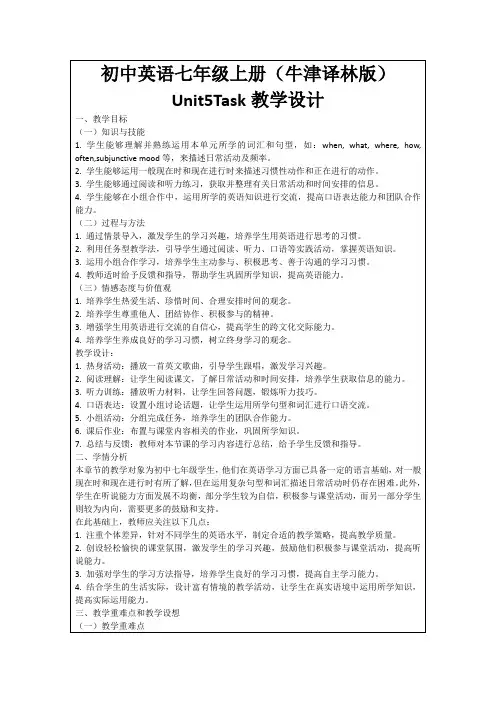
Unit5词汇教案牛津译林版英语七年级上册一、教学内容本节课选自牛津译林版英语七年级上册Unit5的词汇部分,主要涉及Chapter 1中的基础词汇和短语。
详细内容包括:家庭成员的称呼(father, mother, sister, brother等),日常用品(pen, pencil, book, bag等),常见动词(have, do, go, play等)以及常用疑问词(What, How, Who等)。
二、教学目标1. 掌握并运用本节课所学的词汇,能够正确使用它们进行日常交流。
2. 提高学生的听说能力,使他们能够运用所学词汇进行简单的问答和对话。
3. 培养学生的团队协作能力,通过小组活动,共同完成任务。
三、教学难点与重点1. 教学难点:词汇的正确发音和用法,疑问词的引导作用。
2. 教学重点:词汇的识记和应用,以及简单句型的构建。
四、教具与学具准备1. 教具:PPT,黑板,卡片。
2. 学具:英语词汇本,练习册。
五、教学过程1. 导入:通过展示一张家庭照片,引导学生用英语描述照片中的人物和物品,自然引入本节课的词汇学习。
2. 呈现:呈现本节课的词汇,用PPT展示单词和短语,让学生跟读,并注意纠正发音。
3. 实践:设置一个场景,让学生运用所学词汇进行角色扮演,进行对话练习。
4. 例题讲解:讲解词汇的用法,通过例句和场景,让学生理解单词的用法。
5. 随堂练习:分发练习册,让学生完成词汇填空、翻译等题目。
6. 小组活动:分组进行词汇接龙游戏,提高学生的词汇运用能力。
六、板书设计板书分为两部分:左边列出本节课的词汇,右边展示例句和用法。
七、作业设计1. 作业题目:根据所给场景,用本节课的词汇编写一段对话。
答案示例:A: What's this?(这是什么?)B: It's a pen.(这是一支笔。
)A: How do you spell it?(你怎么拼它?)B: PEN.(PEN。
Let’s celebrateTeaching aims and demands:1. To understand clues about a crime2. To read notes on four suspects and decide which suspect is most likely to be guilty Important points:To know the meanings of the words related to a detective story, such as murder, evidence, suspect…Difficult points:To learn to describe a personTeaching procedures:StepⅠLead-in1. Show a flash about the happy scene of Chinese New Year.2. Say: The flash is about a festival. What festival is it about?Present Chinese New Year/ the Spring Festival.3. Say: In Spring Festival, we usually have many activities to celebrate it. Let students watch another flash about Chinese New Year celebrations.Present the word ‘celebrate’ and lead students to read together.StepⅡPresentation.1. Show some pictures related to the festival and get the students to talk about what we usually do at Chinese New Year.Such as: What do we usually wear /get /eat?Present wear new clothes / get red packets / eat delicious food2. Lead the students to read.StepⅢFree talk1. Get students to talk freely about what other Chinese festivals we usually celebrate.2. Then let students speak them out themselves. (If they can’t say them in English, they can say them in Chinese.)3. Say: All of you do a good job, now let’s learn about some Chinese festivals.StepⅣPresentation1. Show pictures about Dragon Boat Festival and talk about them with students together. What do we usually eat /do at Dragon Boat Festival?2. Present rice dumplings/ have a dragon boat race3. Get the students to talk about the pictures about Mid-Autumn Festival and present new words and phrases.StepⅤFree talk1. Say: We have many festivals in our country, but in western countries, they also have their own festivals.2. Get the students to talk with each other and name the western festivals out.StepⅥPresentation1. Let’s learn some western festivals.2. Show Christmas pictures and ask what they usually have in their hom e at Christmas.3. Present Christmas tree / get cards and presents with the help of the pictures.4. Do the same with other western festivalsPresent on Thanksgiving Day turkey/ have a big dinner with the familyat Halloween pumpkin lanterns/ dress up as a ghostStepⅦDoing a match1. Let students match the pictures related to the different learned festivals with the names of the festivals.Chinese New YearChristmasDragon Boat FestivalThan ksgiving DayHalloweena tChristmasMid- Autumn Festival2. Read them together.Step Ⅷ Playing a guessing game1. I have prepared six gift box es, and there is a riddle about a certain kind of festival in each one. Let the students choose one as they like. If they can guess what festival it is about, they will get a little gift related to the festival.2.Theriddles includetwo songs about Christmas and Halloween respectively, two pictures about Mid-Autumn Festival and Dragon Boat Festival which are shown bit by bit, and two introductions about Chinese New Year and Thanks Giving Day. Step IX. Practice1. Say: I would like you to make a dialogue about your favourite festivals. Before it, I will show you a summary, please go through it and read them aloud by yourselves.on Thanksgiving Day2. Let students to work in pairs like this:A: Which is your favourite festival?B: My favourite festival is_________.A: Why do you like______________?B: Because . What festival do you like?A: I like ______________________________.B: What do you usually do at/on ______________?A: __________________________________________________.In addition, some related pictures are shown to help students complete the task well. Step X Watching, reading and answering1. Say: My favourite festival is Chinese. What about E ddie and Hobo’s? Let’s watcha video and find out what festival they are celebrating.2. Get one of them to give the answer.3. Let students read the dialogue freely, and answer the following questions:What is Hobo dressing up as?What will he dress up as then?4. Read the dialogue after the recording together.Step X. Role-play1. Give students some minutes to practice the dialogue.2. Get some pairs to give their performance. (Some masks are prepared to help students perform well.)Step XI. Sublimation1. Say: Different people like different festivals. As we Chinese, we should enjoy our festival, appreciate our festival and love our festival.2. Call on the students appreciate our festival, love our festival and love our country. Step XII Homework1. Finish some exercises.2. Prepare a short talk about my favourite festival.。
Unit5词汇教案牛津译林版英语七年级上册一、教学内容本节课选自牛津译林版英语七年级上册Unit5的词汇部分。
具体内容包括:单词和短语,如football, basketball, tennis, volleyball, pingpong, swim, run, jump, skate, play chess等;以及相关的句型,如“I like to play”, “Do you like to?”等。
二、教学目标1. 学生能够掌握本节课所学的单词和短语,并能正确运用到实际情景中。
2. 学生能够运用所学句型进行交流,询问和回答关于兴趣爱好方面的问题。
3. 学生通过小组合作,培养团队精神和合作意识。
三、教学难点与重点重点:单词和短语的正确发音与拼写,以及句型的运用。
难点:单词football, basketball, tennis, volleyball的发音及拼写;句型“I like to play”和“Do you like to?”在实际情景中的应用。
四、教具与学具准备1. 教师准备单词卡片、图片、录音机等教具。
2. 学生准备练习本、笔等学具。
五、教学过程1. 导入:教师播放一段关于体育运动的视频,引导学生关注本节课的主题。
2. 新课内容呈现:教师展示单词卡片,带领学生学习单词和短语,并进行例句展示。
3. 操练:学生跟随录音,模仿单词和句型的发音;教师组织学生进行小组活动,用所学句型进行问答练习。
4. 课堂互动:教师邀请学生上台表演,展示所学单词和句型。
5. 随堂练习:学生完成练习册上的相关习题,巩固所学知识。
六、板书设计1. Unit5 Words and phrases2. 主要单词和短语:football, basketball, tennis, volleyball, pingpong, swim, run, jump, skate, play chess等3. 句型:I like to play; Do you like to?七、作业设计2. 答案示例:A: I like to play football. How about you?B: I like to play chess. Do you like to play chess, too?A: No, I don't. But I enjoy swimming.八、课后反思及拓展延伸1. 教师反思:关注学生在课堂上的参与度,针对不同学生的学习情况,调整教学方法和节奏。
《Unit 5 Let’s celebrate Reading I》教案Background:The students have learnt the first part of this unit.They have known some names of the festivals.And they even got more information about the festivals such as the food people eat,the activities.Type of lesson:ReadingTeaching aims and learning objectives:The students will be able to:A)1. get to know some information about Halloween.grasp the sentences which are used to talk about Halloween .know the form of a letter.B)2. develop the ability of reading comprehension by organizing different activities.3. know they should be grateful to the people who help them.Teaching Contents:Words: A)(four skills):USA,paint, inside, knock, shout, if, treat, specialB)(three skills):mask,pumpkin lanternPhrases: tell about, in the USA, have lots of fun,dress up,wear masks,play a game with,knock on,play a trick on,on the evening of October 31,like…best Sentences: Thank you for telling me about the Mid-Autumn Festival.If they do not give us a treat, we can play a trick on them.I like Halloween best.Focus of the lesson and predicted area of difficulty1.Help them to grasp the basic words and expressions of Halloween and the basic information of Halloween.2.How to get the main information with the different reading skills.How to use them in the communication.Teaching procedures:Step1 Revision:Free talk:Ask Ss Qs about the date and use the calendar (with a festival init)to lead into the main topic ----festival. Review the festivals in the last lesson.T: what’s the date today? Look at the numbers on the calendar, why some are red? They are festivals. What festivals do you know?Step 2. PresentationShow them a video or a picture of celebration, ask them to guess what festival it is? With the help of the video or the picture, try to teach the new words (pumpkin lantern\mask\treat\inside)Step3 SkimmingRead the form of the letter and answer the Qs:Who is the writer and who is the receiver?When does Wendy write the letter?To teach the correct form of a letter.Step4. Scanning:a.Read the text and find out the answers to this question “what do we do atHalloween?” Give Ss several minutes to scan the text and discuss with their partners.A. Play a game with the people insideB. Dress up and wear masksC. Make pumpkin lanternD. Have a special partyStep5. Consolidation:Do T or F questionsa. People in the USA celebrate halloween in October.b. Halloweeen is not much fun for children.c. People make lanterns out of oranges.d. Children play “trick or treat”with their parents on Halloween.e. People have a party on the evening of 31 October.f. People enjoy nice food and drinks on Halloween.Step6. Post-reading:T: Do you want to know Halloween very well? Let's read the passage paragraphby paragraph and then fill in the blanks. Please work in groups. of four to see which group is the winner1.The people in the USA do not celebrate__________, but they celebrate___________.2.The children ________with the people ually, people give them__________. If they don’t, the children can ____________on them.3.They _______and _________.They also make _______________.4.They always have a _______ on the ___________________.Step 7. Have an interview:T: Now we've known a lot about Halloween. Let's have an interview. If your deskmate is from the USA, ask him or her some questions about Halloween.Step 8. Discussion :What is your favourite festival? Why?T : So much for Halloween . What do you think of it? S:It's...T: Then is it your favourite festival? If not,what is your favourite festival?Please work in pairs. I'll choose several pairs to talk about it.Step 9. Homework :A)Revise the passage and learn the useful phrases and sentences by heart.必做一.翻译1、Thank you for (do) sth 意为2、play a game called ‘trick or treat’.句中你对called如何理解?3、wear special costumes with masks,句中with如何解释?4、give sth. as a treat.意为e.g5、play a trick on sb意为e.g二.单项选择:()1.Sandy,don't play on the old men.A.a trickB. tricksC. trickD.A and B()2.The students will go to Beijing the morning May 25th.A.on,ofB.in,onC.on,on()3.---Happy Halloween!A.Thank youB.Me tooC.You tooD.Happy Halloween()4.Thanks for me your weekend.A.telling, toB.asking, onC.telling,about()5.He was born a cold winter afternoon.A. onB. inC. at()6.I like .But I don’t want now.A.to swim,swimmingB. swimming, to swimC. swimming ,swim()7.You can make a lantern a pumpkin.A.from ofB. ont ofC. out from()8.—Could I have snacks now?---S orry,you can’t have .A. any, anyB.some,anyC.any,some()9.My family always eat at Haloween.A.mooncakesB. rice dumplingsC.turkeyD.chocolates and candies( )10.You can make a lantern a pumpkin.A.from ofB. out ofC. out fromD.fromB)选做三.完形填空The Spring Festival is the Chinese 1 .It usually comes in January or February.Everyone in China 2 the Spring Festival 3 ,Simon usually helps his parents 4 their house and do some shopping and other 5 .6 That day .everyone in China eats Jiaozi,New Year’s cakes and some7 Clelicious food.Simon likes New Year’s cakes.but Sandy says Jiaozi is better.All people are very happy at the Spring Festival.1.( )A.New Year’s Day B.Teachers’ Da y C.Mid-Autumn Festival2.( )A.thanks B.calls C.looks D.likes3.( )A.goes es C.takes D.celebrates4.( )A.want B.get e D.clean5.( )A.housework B.families C.homework D.shopping6.( )A.In B.At C.On D.For7.( )A.another B.other C.others D.the otherUnit 5 Study skillsStep 1 GreetingsStep 2 Presentation1.In this class we’ll learn some vowels.Now look at the screen.kitty says we don’t play football now because it’s rai ning. Please wait for a moment.How do you read these two words?Play sayHow do we pronounce “ay ”?Read after me “play, say” [ei]2. Now look at the screenKitty turns on the light at night.How do you read these two words?night lightHow do we pronounc e “igh”?Read after me “night, light” [ai]3.Now look at the screen.The boy enjoys the toy near the toilet.How do you read these two words?boy enjoyHow do we pronounce “oy”?Read after me “boy, enjoy” [ɔi]4.Now look at the screen.The man in a blue co at knows, “The bowl is in the boat.”How do you read these two words?boat coatHow do we pronounce “oa”?Read after me “boat, coat” [əu]5. Now look at the screen.The man with a big mouth walks down the street, then comes into the brown house. How do you read these two words?house mouthHow do we Pronunce “ou”?Read after me “house, mouth” [au]6. Now look at the scr een.This year I hear the interesting story near the village with my own ears.How do you read these two words?hear nearHow do we pronou nce “ear”?Read after me “hear, near” [iə]7. Now look at the screenThe bear wearing a red coat and a girl with long hair sit on the chair.How do you read the two words?bear wearHow do we pronounce “ear”?Read after me “bear, wear” [eə ]8.Now look at the screen.I’m sure the coming tour to Dongtai is very wonderful .How do you read the two words?sure tourHow do we pronounce “ure, our”?Read after me “sure, tour” [uə ]Step 3 Practice and acti vities1. Listen to the tape, then read after me . P652. Match the following words with the sounds of their letters in bold.3. Look at the pairs of words . Read the words on the left first, then try to say the words on the right correctly. Read in pairs, Students read. Then listen to the tape.4. Compare the two words, judge the sounds in each group. If they have the same sound, say “yes”, if they don’t, say “no”.1.may night ( )2. house now ( )3. show toy ( )4.flower know( )5. mouse mouth( )6. coat borrow( )7. hear here( )8. air dear( )Setp 4 Part C1. Practise saying the following sentences.2. Read the sentences after me. Read them by yourselves.Step 5 HomeworkA)必做1. Read vowels on Page 65.B)选做2. Find out three words with each sound.7AUnit 5 TaskStep 1 warm-up1 Sing an English song ‘Merry Christmas ’2 Free-minute talkStep 2 PresentationT: Nowadays an increasing number of Chinese People are fond of celebrate some western festivals, For example, they send chocolate and flowers to their beloved at Christmas. Can you tell me some western festivals.T: Yes. Thanks giving Day Mothers Day Fathers Day.T: any more? Halloween ?T: Yes. We also have learnt some information about Halloween in this unit .Here are some questions for you to check how much you still remember.1. What is Halloween?2. When is Halloween?3. How do people celebrate it?T: Yes Good. We Chinese also have our own traditional festivals such as. Lantern Festival . Dragon Boat Festival .Mid-Autumn Festival .Spring Festival. Spring Festival is the most important in our culture. Just as important as Christmas Day .Please think these questions .1. What is Spring Festival?2. When is Spring Festival?3. Who celebrate spring Festival?4. How do people celebrate it?Step 3.Doing exercise.T: Open your books and turn to page 67 do part B according to Millie’s writing plan.Step 4 Retelling the text.Step 5 Writing.T: Please write your favorite festivals.Step 6 Homework.A)必做1、庆祝万圣节2、西方人3、春节4、做南瓜灯笼5、举办晚会6、搞恶作剧7、给我们一些糖果 8、装扮9、放烟花 10、收到红包11、穿新衣服 12、春节联欢晚会二、用所给词的适当形式填空。
牛津英语七年级预备课程Unit5 Visit my school 一、教学内容词汇:football field, how many, office, toilet, playground, only, hun dred, beautiful, garden, floor, ground floor, reading room, any, of c ourse, swimming pool, building, library, hall, basketball court, tenn is court, study, draw句型:Is this your school? Yes, it is./No, it isn't. Is there a swimm ing pool in your school? Yes, there is.?No, there isn't. Are there th ree buildings in your school? Yes, there are./No, there aren't. How m any classrooms are there in your school? There is only one./There are six.二、教学目标和要求1. 掌握Is this.....?与Is/Are there......? 的一般疑问句以及它们的肯否定回答。
2. 学会对there be 结构中的数字进行提问。
3. 掌握名词复数的构成规则。
三、教学步骤Step1 Revision1. 默写第四单元的四会单词。
2. 口头翻译一些动词短语或句子。
Step2 Presentation教师说上节课我们介绍了我的教室my classroom. But where is my classroo m? 由此进入我们的话题My school.教师让学生回忆他们学校有些什么,帮助学生复习单词football feild, building, office, toilet, library, hall, a rt room, swimming pool.然后以疑问的口气问他们Is there a swimming pool in your school? Is there a football feild?等等,引导他们回答Yes, th ere is./No, there isn't.接着做Listening中的练习,将Are there.....?结构以及它的肯否定回答复习一下。
如:Are there five offices in Building A? Yes, there are./No, there aren't.最后让学生看25页上的一所学校,数数学校里有多少toilet, playground, hall, classroom, office, library.引出How many.......?结构,并用There is only one.or There are two/thr ee/four.....来回答。
Step3 Practice学生先口头练习步骤二所讲的句型,同桌间可以用问答形式练习。
然后阅读本单元的短文,回答课后问题。
四、知识讲解1. visit my school 中的visit 意思是“参观,访问”,我们可以用它来作为“看望,拜访”讲,如:visit the doctor(看医生),visit my teacher(拜访我的老师)2. Is this/that your + sth?的回答是Yes, it is./No, it isn't.其中this 是近指某物,而that 是远指某物。
但是如果该结构中的sth换成sb.时,它的回答是由所指人的人称代词决定。
如:Is this/that your mother? Yes, she is/No, she isn't.3. there be 的否定形式是在is or are 后面加not,一般疑问句是Be there.....?值得注意的是在There are some.....肯定句中,它的否定句是There aren't any ........它的疑问句是Are there any.......? 如:There are so me classrooms in my school.否定句:There aren't any classrooms in my classroom. 一般疑问句:Are there any classrooms in your school?对ther e be 中数字(不管是a,some还是1以上的数字)进行提问用How many +名词复数+are there.....?如对There is a book on the desk.中的a 进行提问就是How mamy books are there on the desk?4. 名词复数的构成规则:一般情况下,直接在该名词后面加-s,如:boy(s), sister(s),girl(s);如果该名词是以-s,-x,-sh, ch结尾,那么它们的复数是在后面加-es,如:class(es), box(es),.brush(es), watch(es);如果该名词以一个辅音字母+y, 它的复数是去y +ies,如:family---families, baby--ba bies, library--libraries;如果以f,fe结尾的名词去f或fe变成ves。
如:knife--knives,leaf--leaves;还有就是“oo”变“ee”,如:goose--geese, tooth--teeth;还有一些不规则的名词,它们的复数需记忆,如:man--men, w oman--women, policeman--policemen, child--children, mouse--mice,sheep --sheep, fish—fish五、能力训练1.写出下列单词的复数。
boy--------- name--------- family---------- hall----------- glass--------- pencil-box----------library---------- watch------nurse--------- brush---------- man----------- mouse----------- child------------ sh eep------------ clock---------2.用单词的适当形式填空。
(1) There are many _______(class) in our school.(2) Are there any ________ (knife) in the box.(3) How many ________(child) are there in the room?(4) There ________(be) any oranges here.(5) ______ (be) this your classroom? No, it isn't.3.选择填空。
( ) 1. How many _______ are there in the picture?A policemansB policemenC policemanD policemens( ) 2 .There aren't _______ trees near the house. There is only one.A anyB someC muchD many( ) 3. "Are there any maps on the wall?"" ______."A There are some.B Yes, there is.C Yes,there is one.D No, there ar e.( ) 4. There _______ a pen and a ruler in my pencil-box.A is B are C be D have4. 用a, an, the, some, any 填空。
(1) There is ______ apple on ______ table.(2) ---- Is there ______ orange in the bag?---- No, there isn't _____ _.(3) ----How many books are there in your desk?------ There aren't ___ ____.(4) I have ______ good friend.-----She is ______ English girl.(5) Are there ______ chairs in the classroom?------ Yes, there are __ _______.5. 句型转换。
(1) There is a map on the wall.(改否定句)___________________________ ____(2) There are some offices in my school.(改一般问句并做否定回答)_____ ____(3) There are three boys in the classroom.(对斜体部分提问)___________ ______(4) There are some pictures on the bag.(改否定句)_________________(5) Is this a photo of my family?(作肯否定回答)______________________ _______(6) There are some libraries in our school.(对斜体部分提问) _________ ____________六、课后作业1. 抄写四会单词三遍并会默写。
2 .熟读对话和句型。
3 .复习1-5 单元的内容。